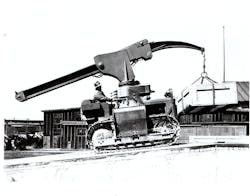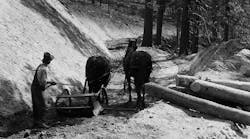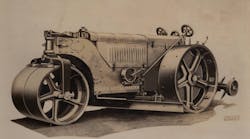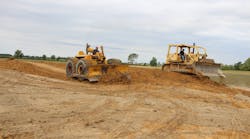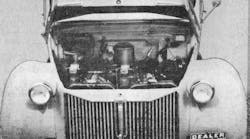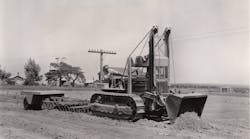In the late 1950s, the self-propelled rough-terrain hydraulic crane came into use in the construction and material handling industries, and in the following years dominated the market as it rendered small lattice-boom cranes obsolete. But like many of today’s machines, this familiar crane had its origins in a machine that bore only a partial resemblance to today’s design.
Admiral Chester Nimitz referred to the crawler dozer as one of America’s four secret weapons during World War II. The basic crawler tractor had come into its own in the 1920s and 1930s as a highly versatile machine capable of handling a wide variety of attachments and allied equipment, including the bulldozer blade, and that flexibility contributed to the development of the hydraulic crane. During the War, the United States Navy needed a compact, highly mobile crane capable of handling munitions over rough terrain and in cramped quarters. Tractor-mounted crane options included sidebooms—swinging booms that were mounted above the hood or onto the rear of the tractor—or A-frame booms on the front or rear of the tractor. None sufficed. All of these booms were of fixed length, and lifting radius was increased or decreased only by raising or lowering the boom. This was problematic in close overhead clearances such as those in which this crane could be required to work.
Austin-Western Road Machinery Co. provided the answer: a fixed-length swing boom that mounted above the engine of an International Harvester crawler tractor. It differed from all other tractor-mounted booms in that the lifting radius could be changed by advancing and retracting the entire boom through its mount. Although the boom did not telescope as on a true hydraulic crane, it was regarded as the first hydraulic crane, because a hydraulic motor powered the boom’s movement. This revolutionary crane was nicknamed the Anteater, because the curvature of the boom tip was oddly reminiscent of an anteater’s snout.
This author has no information on whether or not the Anteater was carried forward into civilian production after the War, but some were likely sold as war surplus. Austin-Western did continue to manufacture the Badger, a half-swing cable excavator built on an industrial tractor’s power train and introduced in the 1950s. John L. Grove developed the first true telescoping-boom hydraulic crane in 1949, and Austin-Western rough-terrain, truck-mounted and pedestal-mounted true hydraulic cranes were major competitors to Grove’s product lines from 1955 until Clark Equipment Co. discontinued the former Austin-Western line in 1980.
The Historical Construction Equipment Association (HCEA) is a 501(c)3 nonprofit organization dedicated to preserving the history of the construction, dredging and surface mining equipment industries. With more than 4,000 members in 25 countries, activities include operation of National Construction Equipment Museum and archives in Bowling Green, Ohio; publication of a quarterly magazine, Equipment Echoes, from which this text is adapted, and hosting an annual working exhibition of restored construction equipment. Individual memberships are $32 within the U.S. and Canada, and $40 elsewhere. Information is available at www.hcea.net, 419.352.5616, or [email protected].
